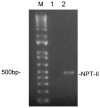Cross-Kingdom Communication via Plant-Derived Extracellular Vesicle Nucleic Acids in Genetically Engineered Nicotiana tabacum
- PMID: 40149507
- PMCID: PMC11942166
- DOI: 10.3390/genes16030356
Cross-Kingdom Communication via Plant-Derived Extracellular Vesicle Nucleic Acids in Genetically Engineered Nicotiana tabacum
Abstract
Background/objectives: Plants release extracellularly lipid bilayer-enclosed vesicles of nanometric size that can be retrieved in their fluids. Plant-derived extracellular vesicles (PDEVs) have mostly been involved in modulating host-pathogen interaction, making them a tool for cross-kingdom communication with a key role in plant immunity. In addition, PDEVs have demonstrated promising therapeutic features, not only in terms of intrinsic nutraceutical properties but also of active molecules' delivery. Transgenic plants have been developed for a variety of purposes, i.e., to improve their functional properties like crops, but also to produce therapeutic molecules. However, it is unclear whether transgenes can end up in PDEVs, thus making them a vehicle for their cross-kingdom diffusion into the environment.
Methods: Here, we investigated the association of transgenic DNA and RNA with PDEVs secreted by tobacco (Nicotiana tabacum) engineered to express the neomycine phosphotransferase II (Npt-II) gene. PDEVs were isolated from leaf apoplastic fluid by ultracentrifugation and characterized for their morphology and size. The association of DNA and RNA was assessed by qRT-PCR and their immunomodulatory properties by assaying PDEVs-induced IL1β and IL10 on THP1 monocytes.
Results: Npt-II RNA, but not DNA, could be amplified from PDEVs, whereas no differences were observed between wt and transgenic tobacco PDEVs in terms of immunomodulatory properties.
Conclusions: Although a different behaviour by other types of RNAs or DNAs could still be possible, our findings indicate that in this model, PDEVs are not associated with transgenic DNA, but they can protect RNA, including transgenic RNA, from degradation, contributing to their cross-kingdom spreading.
Keywords: Nicotiana tabacum; cross-kingdom communication; extracellular RNA; plant-derived extracellular vesicles.
Conflict of interest statement
The authors declare no conflicts of interest.
Figures




References
-
- Calzoni E., Bertoldi A., Cusumano G., Buratta S., Urbanelli L., Emiliani C. Plant-Derived Extracellular Vesicles: Natural Nanocarriers for Biotechnological Drugs. Processes. 2024;12:2938. doi: 10.3390/pr12122938. - DOI
MeSH terms
Substances
LinkOut - more resources
Full Text Sources

